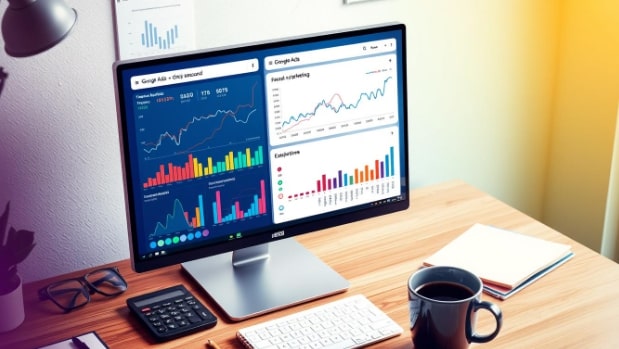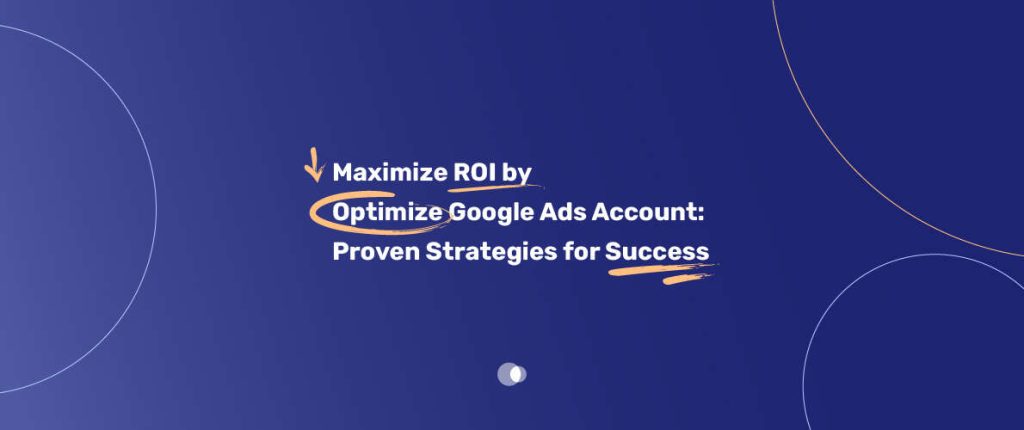In today’s digital world, managing Google Ads accounts is crucial for businesses looking to boost their ROI. Whether you’re operating in Dubai, the UK, the US, or Australia, working with a Google Ads agency Dubai can help you optimize campaigns for maximum results. This guide will show you how to make the most of your Google Ads account, with strategies to unlock the full potential of your advertising campaigns across different markets.
Table of Contents
This article will help you understand Google Ads better. You’ll learn about important performance metrics and how to build a strong campaign structure. It doesn’t matter if you’re new to Google Ads or have experience. This guide will give you the tools to reach your ROI goals and stay competitive.

Key Takeaways
- Understand the fundamentals of Google Ads ROI and key performance metrics
- Implement best practices for optimizing your Google Ads account structure
- Leverage essential campaign settings to maximize your ROI
- Develop a strategic keyword approach and effectively manage bid strategies
- Create high-converting ad copy and optimize landing pages for better results
- Utilize advanced analytics and performance tracking to continuously refine your campaigns
- Stay up-to-date with the latest Google Ads optimization techniques
Understanding Google Ads ROI Fundamentals
Measuring the return on investment (ROI) of your Google Ads campaigns is key. It shows if your digital marketing is working well. Let’s look at the main ideas of Google Ads ROI, like key metrics, how to calculate ROI, and setting goals.
Key Metrics That Define Success
Several key metrics show if your Google Ads campaigns are doing well. These include:
- Click-Through Rate (CTR): This shows how many people click on your ads. It tells you if your ads are interesting and engaging.
- Conversion Rate: This is how many people do what you want them to after clicking on your ad. It could be buying something or filling out a form.
- Cost Per Acquisition (CPA): This is the average cost of getting someone to do what you want. It shows how well your ad spend is working.
The ROI Calculation Formula for Google Ads
To figure out your Google Ads ROI, use this formula:
ROI = (Revenue – Ad Spend) / Ad Spend x 100
This formula helps you see how much of your ad spend is coming back as revenue. It shows if your campaigns are making money.
Setting Realistic ROI Goals
When setting ROI goals for your Google Ads campaigns, think about industry standards and your past results. This helps you set goals that are reachable and match your business goals. By knowing the important metrics and using the right formula, you can make smart choices to improve your campaigns and get more return on investment.
Account Structure Best Practices for Enhanced Performance
Improving your Google Ads account structure is key to better performance and ROI. By using best practices, you can manage campaigns better, target more precisely, and see more success. This is crucial for your google advertise efforts.
Campaign segmentation is a major principle for good account organization. Group your ads and keywords by theme, ensuring each campaign has a clear focus. This lets you customize your strategies for each audience segment.
- Organize campaigns by product categories, customer demographics, or business goals.
- Keep a logical structure, with ad groups inside campaigns for better targeting.
- Always check and improve your campaign structure as market and user trends change.
Ad group optimization is also vital for a well-organized Google Ads account. Put your keywords and ads into groups that share a theme or intent. This makes your ad copy more relevant and engaging for your audience.
“A well-structured Google Ads account is the foundation for driving efficient, high-performing campaigns.”
The Google Ads account organization you set up now will affect your future campaigns. By spending time on a strategic setup, you’ll set your business up for long-term success and growth in digital ads.
Essential Campaign Settings to Maximize ROI by Optimize Google Ads Account
Optimizing your Google Ads account is more than just making great ads. Using key campaign settings can greatly increase your return on investment (ROI). We’ll look at three important areas: geotargeting optimization, device-specific bidding, and ad scheduling refinement.
Location Targeting Optimization
Geotargeting in Google Ads helps you target valuable audiences by location. By looking at your customer data and past campaigns, you can find the best places to reach them. Focus on these areas and avoid less profitable ones to save money.
Device Bid Adjustments
Users interact differently with ads on desktops, tablets, and phones. Device-specific bidding lets you adjust bids for each device. This ensures you spend more on devices that work best. Keep checking your data to adjust bids as user habits change.
Ad Schedule Refinement
When it comes to ad scheduling, timing is everything. Look at your data to find when your audience is most active. Show your ads then and pause them when it’s not as good. This helps your campaign optimization a lot.
Using these key settings can really boost your Google Ads ROI. Your ads will reach the right people at the right time on the best devices. Keep tweaking these settings to make your Google Ads campaigns more efficient and profitable.
Keyword Strategy and Match Type Selection
Creating a good keyword strategy is key to getting the most out of your Google Ads. It starts with keyword research to find the best terms for your business. You look at trends, what competitors do, and what customers search for.
After finding your main keywords, picking the right match types is next. Google Ads has different match types, each good for different things:
- Broad match: It catches a wide range of searches, but might show ads for things not related to your business.
- Phrase match: It targets searches with your exact phrase, giving you more control than broad match.
- Exact match: Your ad shows only for searches that exactly match your keyword, which is very relevant but might not reach as many people.
Negative keywords are also important for your Google Ads. They help by keeping your ads from showing for terms that won’t lead to sales. By regularly checking search term analysis, you can improve your negative keywords and find new chances to grow or improve.

By doing thorough keyword research, choosing the right match types, and using negative keywords well, you can make a focused keyword strategy. This strategy will bring in high-quality traffic and increase your Google Ads ROI.
Creating High-Converting Ad Copy That Drives Results
In the fast-paced world of digital ads, making great ad copy is crucial. It grabs your audience’s attention and boosts conversions. With the right ad copywriting skills, you can make your Google Ads work harder and earn more.
Ad Copy Testing Methods
To make ad copy that converts, you need to test it thoroughly. A/B testing lets you see how different ads perform. This way, you find out what works best. Multivariate testing goes further by testing many elements at once. It gives you a detailed look at the best mix of ad parts.
Extension Optimization
Ad extensions are great for making your Google Ads stand out. They add important details that attract more clicks and conversions. Try different extensions like sitelinks and callouts to see what works best for your business.
Landing Page Alignment
Your ad campaign’s success depends on more than just the ad copy. Your landing page optimization must match the ad’s message. A smooth transition from ad to landing page improves user experience and boosts your Quality Score. This leads to better ROI.
By using these strategies and always testing and improving, you can achieve top results with your Google Ads. Focus on your ad copy, extensions, and landing page alignment to win big.
Bid Management Strategies for Cost Efficiency
Effective bid management is key to getting the most from your Google Ads campaigns. You can choose between manual bidding and automated bidding for bid Optimize Google ads account. Knowing the strengths and weaknesses of each can help you pick the best strategy for your business.
Manual Bidding: Hands-on Control
Manual bidding lets you manage your CPC management closely. You can adjust bids based on your goals and data. But, it takes a lot of time and needs constant checking to stay competitive.
Automated Bidding: Efficiency and Optimization
Automated bidding uses Google’s algorithms to optimize bids in real-time. It helps you reach your goals, like more conversions or ROI, without taking up too much time. But, you have less control over the bidding.
Consider a mix of manual and automated bid optimization for the best of both worlds. This way, you get the efficiency of automated bidding and still have some control over your campaign’s performance.
| Bidding Strategy | Pros | Cons |
| Manual Bidding | Granular control over bidsAbility to adjust bids based on specific goals | Time-consumingRequires constant monitoring |
| Automated Bidding | Efficiency and optimizationAbility to achieve desired results (e.g., conversions, ROI) | Less direct control over the bidding process |
The best bid management strategy for your Google Ads depends on your goals, budget, and campaign complexity. By weighing the pros and cons of each, you can create a strategy that’s cost-efficient and boosts your ROI.

Quality Score Optimization Techniques
In Google Ads, Quality Score is key to success. It can greatly affect your campaign’s performance. By using smart strategies, you can improve this score. This leads to lower costs and better ad placement.
Landing Page Experience Enhancement
Your landing pages are crucial for Quality Score. Make sure they are easy to use and match your ad promises. This means fast page loads, relevant content, and good looks.
By offering a great landing page experience, you can boost your Quality Score. This helps drive more valuable conversions.
Ad Relevance Improvement
How well your ads match the user’s search is important for Quality Score. Improve your keyword use and ad copy. Make sure your ads meet the user’s needs.
By delivering relevant and valuable ads, you can increase your Quality Score. This leads to better ad performance.
Expected CTR Optimization
- Look at your past CTRs to find ways to get better.
- Try different ad styles and calls-to-action to see what works best.
- Keep tweaking your ad copy to keep a high CTR. This is vital for Quality Score.
By mastering these Quality Score optimization techniques, you can get more from your Google Ads. You’ll spend less per click and stand out online.
Advanced Analytics and Performance Tracking
In the digital marketing world, data is key to success. By linking Google Analytics with your Google Ads account, you get a treasure trove of insights. These insights change how you optimize your campaigns. You can track conversion tracking and understand the customer journey better with attribution modeling.
With these insights, you can make smart choices to keep improving and get more from your investment. Use data-driven optimization to tweak your campaigns, adjust bids, and fine-tune your ads. This way, you can see amazing results.
“The key to success in digital marketing is not just creating campaigns, but constantly refining and optimizing them based on data-driven insights.” – Jane Doe, Digital Marketing Strategist
Explore your performance metrics, look at customer touchpoints, and find hidden patterns. These patterns can take your Google Ads campaigns to new levels. Use advanced analytics to boost your marketing.
- Integrate Google Analytics with your Google Ads account for comprehensive data tracking
- Set up detailed conversion tracking to measure the impact of your campaigns
- Utilize attribution modeling to understand the customer journey and optimize accordingly
- Leverage data-driven optimization techniques to continuously refine your campaigns
By using advanced analytics and tracking, you can unlock your Google Ads campaigns’ full potential. This leads to amazing results that boost your profits.
Conclusion
This article has given you a detailed guide to boost your Google Ads ROI. It covers key metrics and advanced strategies for better quality scores and bids. These methods can help you reach your goals.
Success in Google Ads comes from always improving and testing your campaigns. Keep an eye on your performance, adjust to market changes, and use new features. This way, you can stay ahead and beat your rivals. Remember, optimizing Google Ads is a continuous effort, not just a one-time task.
Keep moving forward with a focus on continuous improvement in your Google Ads optimization summary. Stay active in using the ROI maximization strategies we’ve talked about. This will help you get great returns on your ads and strengthen your brand online.
FAQ
1)What are the key metrics that define success in Google Ads?
Success in Google Ads is measured by Click-Through Rate (CTR), Conversion Rate, and Cost Per Acquisition (CPA). These metrics show how well your ads are doing. They help you see if your ads are working well.
2)How do I calculate the ROI for my Google Ads campaigns?
To find the ROI for your Google Ads, use this formula: (Revenue – Ad Spend) / Ad Spend. This formula shows how much money you made from your ads. It helps you decide how to spend your budget better.
3)How can I set realistic ROI goals for my Google Ads campaigns?
Setting ROI goals for Google Ads means looking at industry standards and your past results. Think about your business goals and what you want to achieve. This helps you set targets that are realistic and match your marketing plans.
4)What are the best practices for organizing my Google Ads account structure?
Organizing your Google Ads account well is important. Use a clear structure based on products, services, or audience. This makes managing your ads easier and helps you target better.
5)How can I optimize my location targeting to improve ROI?
To get better ROI, focus on targeting the right places. Check your settings to make sure you’re targeting the right areas. Adjust your bids or exclude places that don’t work well to boost your ROI.
6)How can I use device bid adjustments to enhance my Google Ads performance?
Device bid adjustments help you spend your budget wisely. Look at how your ads do on different devices. Adjust your bids to make the most money from the best devices.
7)How can I refine my ad schedules to improve campaign efficiency?
Adjusting your ad schedules can make a big difference. Look at when your audience is most active. Set your ads to run during those times to get the best results.
8)What are the best practices for keyword research and match type selection?
Good keyword research and match types are key. Use tools like Keyword Planner to find the right keywords. Try different match types to find the best balance between reach and relevance.
9)How can I create high-converting ad copy that drives results?
Great ad copy is essential for success. Use A/B and multivariate testing to find what works best. Also, make sure your ad extensions and landing pages match your ad copy for a better user experience.
10)What bid management strategies can I use to achieve cost efficiency?
To keep costs down, manage your bids well. Try both manual and automated bidding. Adjust bids based on keyword performance and conversion data to get the most out of your budget.
11)How can I optimize my Quality Score to improve ad performance?
Quality Score affects your ad rank and costs. Improve your Quality Score by enhancing landing pages and ad relevance. Also, work on your expected click-through rate to reduce costs and improve ad position.
12)What advanced analytics and performance tracking techniques can I use to drive continuous optimization?
Advanced analytics and tracking are crucial for ongoing improvement. Use Google Analytics and set up detailed conversion tracking. Understand the customer journey with attribution modeling. Analyze your data to find ways to improve and make informed decisions.



